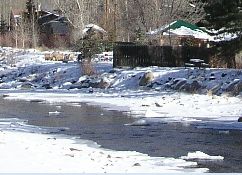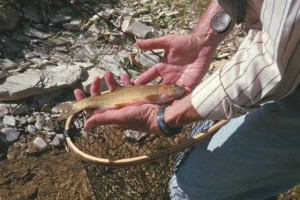Last week, congressional leaders agreed to a bipartisan omnibus appropriations bill for fiscal year 2016. By and large, Trout Unlimited is very pleased with the bill. It provides strong funding levels for many important federal conservation programs and does NOT include a number of harmful policy riders that were in play leading up to the final agreement. We recognize the profound challenges that accompany the appropriations process, and are grateful to Congressional leaders for reaching consensus on a bill that invests in conservation and supports the interests of sportsmen and women.
Of special interest to Trout Unlimited and our members across the country, the Omnibus bill includes the following highlights:

Clean Water Rule
Trout Unlimited is delighted to see that the bill does NOT include the ill-conceived Clean Water Rule rider that was intended to delay or block the Rule restoring Clean Water Act protections to smaller streams and adjacent wetlands. We deeply appreciate the efforts of the Obama Administration and our allies in Congress who stood firm with Trout Unlimited members, American sportsmen and women, and the nearly one million individuals who supported the rule. Hunters and anglers care deeply about protecting headwater streams and wetlands and we are thankful Congress maintained the vital effort to restore Clean Water Act safeguards to these waters. [Colorado TU adds: Senator Michael Bennet stood strong in support of the Clean Water Rule which helps ensure that the Clean Water Act continues to apply to our Colorado headwater/tributary streams. Read more about the issue here.]
LWCF

While Trout Unlimited was disappointed that the Land and Water Conservation Fund (LWCF) was not permanently extended in the omnibus bill, it was reauthorized for an additional three years. In addition, the omnibus directs that the LWCF will receive $450 million in the coming year, which is $100 million more than in 2015, and more than the LWCF has been appropriated since 2010. These provisions represent a step in the right direction for the LWCF and will provide Trout Unlimited with good footing to work with member of Congress in the years ahead to secure permanent authorization for the program. [Colorado TU adds: Senators Cory Gardner and Michael Bennet fought long and hard to support LWCF and deserve thanks from Colorado's sportsmen, and we look forward to working with them to ultimately secure a permanent reauthorization for one of the nation's most effective conservation programs.]
Support for Abandoned Mine Clean-up

In western mine lands and in eastern coal country, Trout Unlimited has invested a huge amount of time and effort in cleaning up pollution from abandoned mine lands to restore trout watersheds. Thus Trout Unlimited was particularly pleased to see the addition of $90 million dollars to the Abandoned Mine Reclamation Fund in the omnibus bill. This is a significant increase over previous years that will allow States with to tackle some of their larger economic, community, and environmental goals related to the reclamation of abandoned coal mines.
Sage Grouse
Why does Trout Unlimited care about the controversial bird? Because sage grouse are especially dependent on riparian areas along trout streams in the western U.S., and what is good for the bird is good for the trout. Earlier this year the FWS decided not to list the Greater Sage Grouse under the Endangered Species Act, opting instead to formulate, along with the states and other Interior Department agencies, a set of comprehensive conservation plans for the imperiled western bird. Trout Unlimited is pleased that the omnibus did not include riders to delay, defund, or otherwise undo the sage grouse conservation plans and instead provides funding to support the cooperative approach identified by the FWS.
Fish Passage
The omnibus includes $13,248,000 for the National Fish Passage Program within the FWS, one of the most cost-effective programs among all federal natural resource agencies. This is a roughly $500,000 increase over last year’s funding. Barriers to fish passage pose a serious threat to the health and sustainability of trout and salmon populations across the country, and the new funds will catalyze new projects around the Nation. [Colorado TU adds: this program provided valuable funding here in Colorado to help restore fish passage associated at water diversion sites that were damaged in the September 2013 floods, allowing Colorado to rebuild smarter and better.]
Western Drought and Basin-Scale Restoration Programs
Trout Unlimited is pleased that the Omnibus provided $100 million for Western Drought Response to enable states, farmers and other water users to conserve water and protect fish habitat in the face of the very serious western drought. The funds will be especially valuable in states hard hit by drought such as California and Washington. The bill also provides considerable funding for the Yakima River Basin (Washington) Water Enhancement Project. Trout Unlimited and its partners have worked extremely hard in recent years to come up with an extensive plan to enhance the Yakima River and its watershed. The culmination of this collaborative effort is a 30-year restoration plan aimed at securing water supplies in the face of worsening drought conditions and restoring habitat throughout the watershed to the betterment of fish, wildlife, and sportsmen.
Wildfire borrowing
The number of large wildfires in recent years has driven up wildfire fighting and suppression costs to a point where the U.S. Forest Service now spends more than half of its budget on wildfires. To cover these rising costs, the Forest Service has been forced to divert or “borrow” money from other programs within the agency. Borrowing results in the delay or outright cancellation of projects aimed at improving fish and wildlife habitat, trails and recreational areas, and efforts to make our national forests more resistant to future wildfires. Trout Unlimited supports the proposed fix for this troubling scenario contained within the Wildfire Disaster Funding Act (WDFA). Although WDFA was not included in the bill, the good news is that appropriators provided the Forest Service and BLM with a substantial increase, nearly $600 million more than what they have spent on average over the last decade. In the long-term a more permanent fix is required, but for now the big increase in funding may be enough to avoid program pilfering in the coming year.
Farm Bill Conservation program cut
A loss for trout conservation was in the USDA NRCS portion of the bill, where NRCS’s large, work horse program, the Environmental Quality Program (EQIP), was trimmed $321 million, a very significant amount. EQIP is vital to conserving streams and rivers on farm lands nationwide by itself, but it also partially funds RCPP, NRCS’s landscape scale conservation program. Still, EQIP’s total is still a significant $1.3 billion, and it will yield considerable benefit to trout nationwide.
Great Lakes Restoration Initiative
The spending bill would provide $300 million for the EPA’s Great Lakes Restoration Initiative (GLRI), a funding program that fosters partnerships among state, federal and local governments, nonprofits, businesses, and other stakeholders to restore habitat and improve water quality in the Great Lakes basin. Support through the GLRI is enabling TU to restore trout habitat in partnership with national forests in Michigan and Wisconsin. The administration had requested $250 million for the effort, and we appreciate the Congress showing its commitment to the Great Lakes by maintaining the program at $300 million.
Chesapeake Bay Program
The EPA’s Chesapeake Bay Program, which plays an important role in improving the health of trout streams in the Bay watershed’s headwaters, received level funding at $73 million. Importantly, Congress maintained $6 million in funding for the EPA’s Small Watershed grant program administered by the National Fish and Wildlife Foundation, through which TU is working with partners in West Virginia, Virginia, and Pennsylvania on habitat restoration projects.
Considering the partisan fighting that has characterized this Congress, formulation of such a strong bill is a remarkable achievement. Trout Unlimited salutes Congress and the Obama Administration for getting the job done.
This post was written by Steve Moyer, TU’s vice president for government affairs. He works from TU’s Arlington, Va., headquarters.








 great way to save money. And like most things, the correct answer is, "It depends." The initial cost of purchasing the tools and materials can range anywhere from $50-200+ but, again, this depends on the quality and quantity of materials.
great way to save money. And like most things, the correct answer is, "It depends." The initial cost of purchasing the tools and materials can range anywhere from $50-200+ but, again, this depends on the quality and quantity of materials.









 Mining Law.
Mining Law. notable spill, the same tragedies are happening throughout the west. The Uncompahgre River near Ouray is lifeless until the metals fall into the depths of Ridgeway Reservoir. The upper Animas River suffers mine waste that steadily drains into the river at a volume equal that of the Gold King Mine spill once a week.
notable spill, the same tragedies are happening throughout the west. The Uncompahgre River near Ouray is lifeless until the metals fall into the depths of Ridgeway Reservoir. The upper Animas River suffers mine waste that steadily drains into the river at a volume equal that of the Gold King Mine spill once a week.
 - Beyond being an awesome angler, what else do you do in your spare time or for work?
I’m semi-retired, still working a couple of days per week as an allergy and asthma doctor in a practice I’ve been devoted to for over 25 years. I love to hunt elk, deer, and pheasant. I also play drums with a weekly jazz group, cycle regularly, and still cut my lawn and own several chainsaws to keep in shape.
- Beyond being an awesome angler, what else do you do in your spare time or for work?
I’m semi-retired, still working a couple of days per week as an allergy and asthma doctor in a practice I’ve been devoted to for over 25 years. I love to hunt elk, deer, and pheasant. I also play drums with a weekly jazz group, cycle regularly, and still cut my lawn and own several chainsaws to keep in shape. This is great news for those along the Colorado River basin that are depending on a wet winter to bring life back to their crops, reduce drought conditions, and replenish
their reservoirs.
This is great news for those along the Colorado River basin that are depending on a wet winter to bring life back to their crops, reduce drought conditions, and replenish
their reservoirs.


